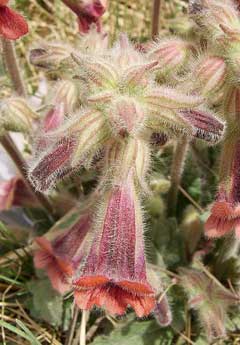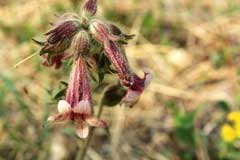 |
|
http://commons.wikimedia.org/wiki/User:Shizhao |
 |
|
Translate this page:
Summary
Physical Characteristics

 Rehmannia glutinosa is a PERENNIAL growing to 0.3 m (1ft) by 0.3 m (1ft in).
Rehmannia glutinosa is a PERENNIAL growing to 0.3 m (1ft) by 0.3 m (1ft in).
See above for USDA hardiness. It is hardy to UK zone 9. It is in flower from April to June, and the seeds ripen from May to July. The species is hermaphrodite (has both male and female organs) and is pollinated by Insects.
Suitable for: light (sandy) and medium (loamy) soils and prefers well-drained soil. Suitable pH: mildly acid, neutral and basic (mildly alkaline) soils. It can grow in semi-shade (light woodland) or no shade. It prefers moist soil.
UK Hardiness Map
US Hardiness Map
Synonyms
Chirita chanetii. Rehmannia chinensis. Gerardia glutinosa. Digitalis glutinosa.
Plant Habitats
Woodland Garden Sunny Edge; Dappled Shade; Shady Edge;
Edible Uses
Edible Parts: Leaves Root
Edible Uses:
Leaves[177, 179]. No further details are given. Root - cooked[177]. Boiled nine times before it is eaten[179]. This suggests that the root is somewhat toxic, or at least has a very bitter flavour. Having boiled it nine times (and presumably throwing the water away each time), there is going to be very little left in the way of vitamins and minerals[K].
References More on Edible Uses
Medicinal Uses
Plants For A Future can not take any responsibility for any adverse effects from the use of plants. Always seek advice from a professional before using a plant medicinally.
Antiseptic Cardiac Diuretic Eczema Febrifuge Haemostatic Hypoglycaemic Skin
Tonic
This plant, called Di Huang in China, is commonly used in Chinese herbalism, where it is one of the most popular tonic herbs and is considered to be one of the 50 fundamental herbs[218, 238]. The root is the main part used and it can be prepared in four different ways - charcoaled, prepared (but no details of the preparation are given) when it is called Shu Di Huang and fresh or dried when it is called Sheng Di Huang[176]. The roots are antibacterial, antiseptic, cardiac, diuretic, febrifuge, haemostatic, hypoglycaemic and tonic[61, 176, 178, 218, 238, 279]. They are used in the treatment of a wide range of ailments, including anaemia, cancer, bleeding, constipation, coughs, fever and premature ejaculation[174, 176, 218, 238]. The charcoaled root is used to stop bleeding and tonify the spleen and stomach[176]. The fresh root is used to treat thirst, the rash of infectious diseases and bleeding due to pathological heat[176]. The dried root is used to treat bleeding due to blood deficiency and to nourish the vital essence[176]. The prepared root is used to treat dizziness and palpitations due to anaemia or blood deficiency, chronic tidal fever, night sweats, dry mouth, lumbago and nocturnal emissions[176]. The roots of cultivated plants are harvested in the autumn or early winter, whilst wild plants are harvested in early spring[238]. They can be used fresh or dried[238]. The root is an ingredient of 'Four Things Soup', the most widely used woman's tonic in China[254]. The other species used are Angelica sinensis, Ligusticum wallichii and Paeonia lactiflora[254]. The leaves are bruised and used in the treatment of scaly eczema or psoriasis[218].
References More on Medicinal Uses
The Bookshop: Edible Plant Books
Our Latest books on Perennial Plants For Food Forests and Permaculture Gardens in paperback or digital formats.

Edible Tropical Plants
Food Forest Plants for Hotter Conditions: 250+ Plants For Tropical Food Forests & Permaculture Gardens.
More

Edible Temperate Plants
Plants for Your Food Forest: 500 Plants for Temperate Food Forests & Permaculture Gardens.
More

More Books
PFAF have eight books available in paperback and digital formats. Browse the shop for more information.
Shop Now
Other Uses
References More on Other Uses
Cultivation details
Requires a light freely-draining humus-rich loam in light shade[200]. Prefers a neutral to acid sandy soil[238]. Requires a warm sunny position[188, 238]. This species is probably hardy to about -25°c if the plants are dry, but the softly hairy leaves are susceptible to rot in warm damp winters and so the plants are often grown in the greenhouse[187]. The plants are prone to fungal infections, especially when grown in damp conditions[238]. The Chinese foxglove is cultivated as a medicinal plant in China[238].
References Carbon Farming Information and Carbon Sequestration Information
Temperature Converter
Type a value in the Celsius field to convert the value to Fahrenheit:
Fahrenheit:
The PFAF Bookshop
Plants For A Future have a number of books available in paperback and digital form. Book titles include Edible Plants, Edible Perennials, Edible Trees,Edible Shrubs, Woodland Gardening, and Temperate Food Forest Plants. Our new book is Food Forest Plants For Hotter Conditions (Tropical and Sub-Tropical).
Shop Now
Plant Propagation
Seed - sow autumn or spring in a greenhouse[188]. Prick out the seedlings into individual pots when they are large enough to handle and grow them on for at least their first winter in a greenhouse. Plant them out in late spring or early summer. Root cuttings in winter[200]. Division in spring[238]. Basal cuttings in late spring or early summer[200]. Harvest the shoots with plenty of underground stem when they are about 8 - 10cm above the ground. Pot them up into individual pots and keep them in light shade in a cold frame or greenhouse until they are rooting well. Plant them out in the summer.
Other Names
If available other names are mentioned here
Native Range
TEMPERATE ASIA: China (Gansu Sheng, Hebei Sheng, Henan Sheng, Jiangsu Sheng, Liaoning Sheng, Nei Mongol Zizhiqu, Shaanxi Sheng, Shandong Sheng, Shanxi Sheng)
Weed Potential
Right plant wrong place. We are currently updating this section.
Please note that a plant may be invasive in one area but may not in your area so it's worth checking.
Conservation Status
IUCN Red List of Threatened Plants Status :

Growth: S = slow M = medium F = fast. Soil: L = light (sandy) M = medium H = heavy (clay). pH: A = acid N = neutral B = basic (alkaline). Shade: F = full shade S = semi-shade N = no shade. Moisture: D = dry M = Moist We = wet Wa = water.
Now available:
Food Forest Plants for Mediterranean Conditions
350+ Perennial Plants For Mediterranean and Drier Food Forests and Permaculture Gardens.
[Paperback and eBook]
This is the third in Plants For A Future's series of plant guides for food forests tailored to
specific climate zones. Following volumes on temperate and tropical ecosystems, this book focuses
on species suited to Mediterranean conditions—regions with hot, dry summers and cool, wet winters,
often facing the added challenge of climate change.
Read More
Expert comment
Author
(Gaertn.)Steud.
Botanical References
109200266
Links / References
For a list of references used on this page please go here
Readers comment
| Add a comment |
|
If you have important information about this plant that may help other users please add a comment or link below. Only comments or links that are felt to be directly relevant to a plant will be included. If you think a comment/link or information contained on this page is inaccurate or misleading we would welcome your feedback at [email protected]. If you have questions about a plant please use the Forum on this website as we do not have the resources to answer questions ourselves.
* Please note: the comments by website users are not necessarily those held by PFAF and may give misleading or inaccurate information.
To leave a comment please Register or login here All comments need to be approved so will not appear immediately.
|
Subject : Rehmannia glutinosa
|
|
|
|